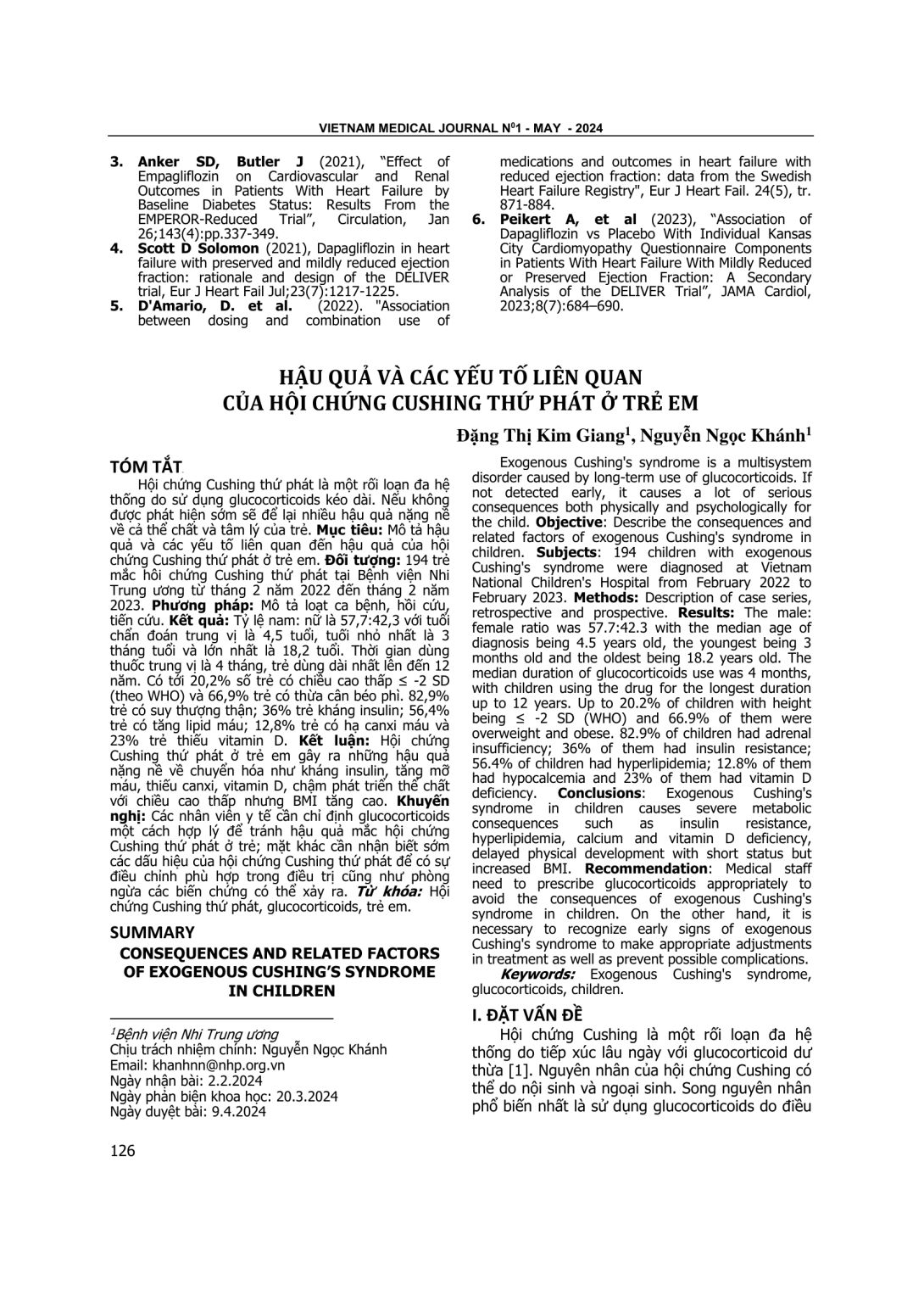
Hội chứng Cushing thứ phát là một rối loạn đa hệ thống do sử dụng glucocorticoids kéo dài. Nếu không được phát hiện sớm sẽ để lại nhiều hậu quả nặng nề về cả thể chất và tâm lý của trẻ. Mục tiêu: Mô tả hậu quả và các yếu tố liên quan đến hậu quả của hội chứng Cushing thứ phát ở trẻ em. Đối tượng: 194 trẻ mắc hôi chứng Cushing thứ phát tại Bệnh viện Nhi Trung ương từ tháng 2 năm 2022 đến tháng 2 năm 2023. Phương pháp: Mô tả loạt ca bệnh, hồi cứu, tiến cứu. Kết quả: Tỷ lệ nam: nữ là 57,7:42,3 với tuổi chẩn đoán trung vị là 4,5 tuổi, tuối nhỏ nhất là 3 tháng tuổi và lớn nhất là 18,2 tuổi. Thời gian dùng thuốc trung vị là 4 tháng, trẻ dùng dài nhất lên đến 12 năm. Có tới 20,2% số trẻ có chiều cao thấp ≤ -2 SD (theo WHO) và 66,9% trẻ có thừa cân béo phì. 82,9% trẻ có suy thượng thận; 36% trẻ kháng insulin; 56,4% trẻ có tăng lipid máu; 12,8% trẻ có hạ canxi máu và 23% trẻ thiếu vitamin D. Kết luận: Hội chứng Cushing thứ phát ở trẻ em gây ra những hậu quả nặng nề về chuyển hóa như kháng insulin, tăng mỡ máu, thiếu canxi, vitamin D, chậm phát triển thể chất với chiều cao thấp nhưng BMI tăng cao. Khuyến nghị: Các nhân viên y tế cần chỉ định glucocorticoids một cách hợp lý để tránh hậu quả mắc hội chứng Cushing thứ phát ở trẻ; mặt khác cần nhận biết sớm các dấu hiệu của hội chứng Cushing thứ phát để có sự điều chỉnh phù hợp trong điều trị cũng như phòng ngừa các biến chứng có thể xảy ra.
Exogenous Cushing's syndrome is a multisystem disorder caused by long-term use of glucocorticoids. If not detected early, it causes a lot of serious consequences both physically and psychologically for the child. Objective: Describe the consequences and related factors of exogenous Cushing's syndrome in children. Subjects: 194 children with exogenous Cushing's syndrome were diagnosed at Vietnam National Children's Hospital from February 2022 to February 2023. Methods: Description of case series, retrospective and prospective. Results: The male: female ratio was 57.7:42.3 with the median age of diagnosis being 4.5 years old, the youngest being 3 months old and the oldest being 18.2 years old. The median duration of glucocorticoids use was 4 months, with children using the drug for the longest duration up to 12 years. Up to 20.2% of children with height being ≤ -2 SD (WHO) and 66.9% of them were overweight and obese. 82.9% of children had adrenal insufficiency; 36% of them had insulin resistance; 56.4% of children had hyperlipidemia; 12.8% of them had hypocalcemia and 23% of them had vitamin D deficiency. Conclusions: Exogenous Cushing's syndrome in children causes severe metabolic consequences such as insulin resistance, hyperlipidemia, calcium and vitamin D deficiency, delayed physical development with short status but increased BMI. Recommendation: Medical staff need to prescribe glucocorticoids appropriately to avoid the consequences of exogenous Cushing's syndrome in children. On the other hand, it is necessary to recognize early signs of exogenous Cushing's syndrome to make appropriate adjustments in treatment as well as prevent possible complications.
- Đăng nhập để gửi ý kiến
